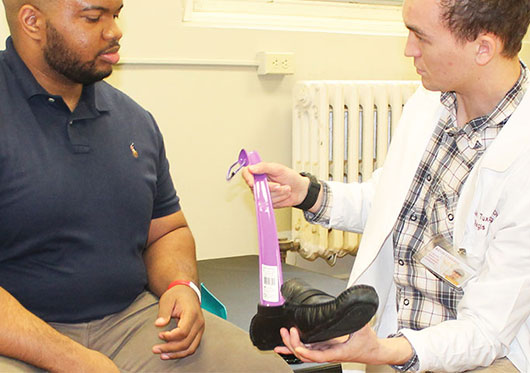For many people who are considering a career in the healthcare industry, there are two career paths that are often considered at the same time: Occupational therapy and nursing. Both professions involve working closely with patients in a healthcare setting in order to make their lives better.
“Nurses and occupational therapists are both focused on improving people’s health and independence through direct personalized care,” says Michael Roberts, director of the occupational therapy program at Regis College. “In fact, one hundred years ago, many of the first occupational therapists were actually specially trained nurses.”
Other similarities include the fact that nurses and occupational therapists are often found working in the same settings (schools, hospitals, community-based care settings). This creates a great deal of respect between the professions, as occupational therapists understand and appreciate the work done by nurses and vice versa. Both of them strive to provide the best care to patients every single day.
While nurses and occupational therapists share a commitment to improving lives, their roles are distinct in meaningful ways. Let’s explore what sets these two vital healthcare careers apart.
Key Takeaways
- A career in occupational therapy focuses on helping individuals regain independence through personalized rehabilitation plans.
- A career in nursing centers on providing direct medical care, including diagnosing, managing treatments, and supporting patients through health challenges.
- Becoming an occupational therapist typically requires earning a Master of Science in Occupational Therapy (MS OT) and passing state licensing exams, while nurses need to complete a nursing degree program and obtain relevant licensure.
- Occupational therapists earn approximately $96,370 annually, while registered nurses earn about $86,070, and nurse practitioners average $129,480 per year.
What is Occupational Therapy?
Occupational therapy is a field in the healthcare industry in which practitioners work with individuals to positively impact the person’s ability to perform the activities associated with daily life. Often, these are individuals who have experienced or are experiencing a condition such as a birth injury or defect, sensory processing disorder, traumatic injuries to the brain or spinal cord, mental or behavioral disorders, etc.
Those working in occupational therapy can hold a number of different job titles and positions. The most common of these include: occupational therapy aides, assistants, and physical therapists.
Occupational Therapy Assistants and Aides
Occupational therapy aides and assistants are both supportive roles that are critical to the successful functioning of an occupational therapy team. They typically work under the supervision of an occupational therapist in order to support patients who are undergoing rehabilitation, which may involve a range of duties focused on patient support.
Individuals interested in working as an OT aide can often do so with just a high school diploma, and many students interested in the OT career path choose to work in this capacity while studying. OT assistants, on the other hand, must typically earn their associate's degree, and earn an average annual salary of $57,657.
Occupational Therapists
Occupational therapists are directly involved in performing a range of daily tasks. This includes:
- Evaluating potential patients to determine their needs
- Designing a treatment plan to address these needs
- Helping patients perform everyday tasks utilizing a range of rehabilitation methods
Individuals seeking to become an occupational therapist must earn their MS in OT and pass their state’s licensing requirements in order to practice. They earn an average salary of approximately $96,370 per year. According to the Bureau of Labor Statistics, the field is expected to grow at an average rate of 11 percent between 2023 and 2033.
What is Nursing?
Like occupational therapy, nursing is a field within the healthcare industry which is focused on providing care to a range of patients, which may be either individuals, families, or whole communities. The types and level of care provided by nurses can vary substantially depending on the situation, level of need, and setting, but may run the gamut from assessments and preventative care through diagnosis and acute and chronic care.
Nurses go by a number of different titles depending on their level of seniority and the extent of their education and training. Two of the most common career paths for nurses include becoming either a registered nurse or a nurse practitioner.
Both registered nurses and nurse practitioners interact directly with patients in order to assess their health and treat their needs; both roles can also be found in a range of settings.
The primary difference between the two positions is the level of autonomy that each enjoys. Registered nurses, for example, typically work under the supervision of a nurse practitioner, manager, or physician to monitor patients, maintain records, order diagnostic tests, consult, communicate with the patient and his or her family members, and assist physicians with their duties. Nurse practitioners, on the other hand, typically have more freedom to assess and interpret patient health, generate treatment plans, diagnose acute illness, and even potentially prescribe medication.
Individuals interested in becoming a registered nurse must typically have completed a minimum of an associate's degree in nursing (ASN). They earn an average annual salary of $86,070. Nurse practitioners must complete their Master of Science in Nursing (MSN), and earn an average annual salary of $129,480.
Is Occupational Therapy Harder Than Nursing?
Deciding whether occupational therapy is harder than nursing depends on your personal strengths, career goals, and interests. Nursing usually takes place in fast-paced, high-pressure settings. It requires strong clinical skills, quick decision-making, and the ability to respond to emergencies.
On the other hand, occupational therapy focuses on helping patients recover in a personalized way. It involves creative problem-solving and adjusting care plans to improve daily life. Both careers need advanced education, clinical experience, and a commitment to patient care. In the end, neither career is harder; it depends on which skills and work environment fit your career goals better.
Nursing vs. Occupational Therapy: Key Differences

On a granular level, there are many important differences between occupational therapy and nursing.
For example, as discussed above, OTs and nurses can expect to earn different annual salaries from one another (though compensation is relatively generous for both careers). Similarly, pursuing either career obviously requires an individual to pursue a different educational path—an MS in OT for occupational therapy and an ASN or MSN for nursing.
But, perhaps the most important differences between the two fields are the scope of duties that each performs, as well as the how and the why of the profession.
“Nurses work to heal people by providing direct care with a focus on medical issues that negatively impact people’s lives,” Roberts says. “They are the beating heart of our healthcare system. In contrast, occupational therapists don’t do things to people; we do things with people.”
For example, after a hip fracture a nurse will likely help assess the patient, perform dressing changes after surgery, help with pain management, and assist with self-care while the patient is recovering.
Meanwhile, an occupational therapist will assess what activities and roles are most important to the client after their hip fracture and find ways to teach them to be independent again so that they can live the life they want to live and resume the roles that help define who they are. This might mean adapting the home environment by installing railings or other supports. It might involve teaching energy conservation strategies so that the patient can rebuild their stamina. It could require teaching the use of adapted equipment for self-care tasks, training in safety with functional mobility, or helping solve any other obstacles to independence the client encounters during their recovery.
Is Occupational Therapy or Nursing Better for You?

There are many factors that individuals should consider before choosing to pursue any career, especially when making the decision between occupational therapy and nursing. Ask yourself:
- What salary do you need to earn in order to justify the expense of completing your degree and continue to live the lifestyle that you want?
- How much time and energy are you willing to invest in your education and ongoing career development?
- What types of environments do you want to work in?
- What type of work do you want to spend the rest of your life doing?
Perhaps most importantly: What kind of impact do you want to have on the lives of your patients?
“If you are looking to provide direct patient care for clients in need of personal or medical care and help people manage medical issues through medications, wound management, pain management, and direct hands-on care, then, nursing might be for you,” Roberts says.
“On the other hand, if you believe that there is an inherent power in activities that are meaningful to people, and that this inherent power can be wielded artfully and skillfully to teach skills, build or rebuild lives, restore independence and quality of life in a wide variety of settings and populations, then occupational therapy might be a better fit.”
Are you considering a career in either occupational therapy or nursing? Learn more about the degree programs offered by Regis College, including the Master of Science in Occupational Therapy and the Master of Science in Nursing to find the path that makes most sense to you!







